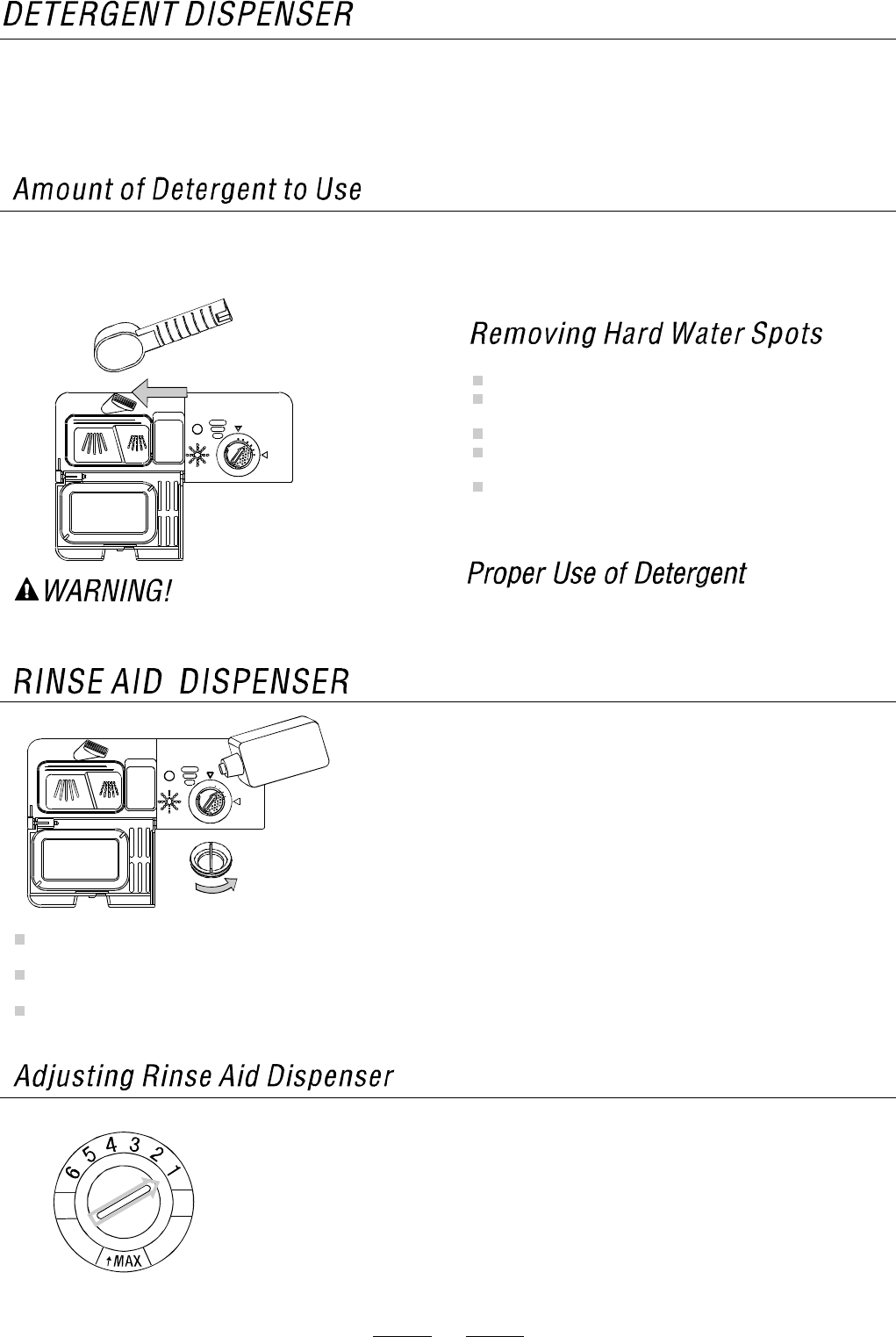
5
Dishwasher detergent iscorrosive! Take care to keepitout
of reach of children.
IF THE WATER ISN'T TOOHARD, YOU MAY ALSO PREVENT THE FORMATION OF DEPOSITSBY ADDING DETERGENT.
The amountofdetergent needed can vary dueto differences in water hardness. To determinethewater hardness inyour area,
contact your local water utility or area water softening company. The harder the water, the more detergent you may need.
Remember, you should adjust the amount of detergent youuse by small amounts until you find the correctamount.
Toremove hard water spots, try the following:
Run dishes through a normal wash program.
Remove all metal dishware,such ascutlery, pans,etc.,
from thedishwasher.
Do not adddetergent.
Pour two cups of vinegar into a bowland set the bowl face
up on thelower rack ofthe dishwasher.
Runthedishes througha normalwashprogram.
If this doesn't work, try the same process with 1 / 4 cup of
citric acid crystals instead of vinegar.
Use only detergent specifically made for usein dishwashers.
Keep your detergent fresh and dry.Don't put powder detergent
into the dispenser until You're ready to wash dishes.
Therinse aidis releasedduring the final rinse toprevent water
fromformingdroplets on your dishesthatcanleave spots and
streaks. It also improves drying by allowing water to"sheet" off
the dishes.
Your dishwashers are designed to use liquid rinse aids. The
rinse aiddispenser is locatedinside the door next tothe
detergent dispenser. Tofill the dispenser,open thecap and
pour the rinse aidintothe dispenser until the level indicator
turns completely black. The dispenser holds about 100 ml of
liquid rinse aid.
Becareful not to overfillthedispenser,becausethiscould
cause oversudsing. Wipe away any spills with a damp cloth.
Don't forget to replace the cap before you closethe dishwasher
door.
If you have soft water,you may not need rinse aid for it may
cause a whitefilmto develop onyourdishes.
YOU MAY NOT ADDTOO MUCH DETERGENT TO PREVENT THE FORMATIONOF DEPOSITS BECAUSEYOURDISHWASHERS
HAVE SPECIALLY-DESIGNED WATER SOFTENERS.
The dispensermust be refilled before the start of each wash cycle following the instructionsprovidedinthe" Wash Cycle
Table".Your dishwashers than conventional dishwashers. Generally, only one tablespoon of
detergent isneeded for a normal washload. Also, more heavily soiled itemsneed more detergent. Always add thedetergent just
before startingdishwasher, otherwise it could get damp and will not dissolve properly.
use lessdetergentand rinse aid
To open the dispenser, turn thecap to the "open" (left)
arrow and lift itout.
Pour the rinse aidintothedispenser, being careful not to
overfill.
Replace the cap by inserting it aligned with "open" arrow
and turning it to the closed (right) arrow.
A measured amount of rinse aid is releasedduring thefinalrinse.As withdetergent, the amount
of rinse aid neededfor your dishes depends on the hardness of thewater in your area.Too much
rinse aid can result in lather offoaming and cause cloudiness or steaks on your dishes.If the
water in your area is very soft, you may not need rinse aid. If you do,you can dilute the rinse aid
with an equal amount of water.
The rinse aid dispenserhas six settings. Always start withthedispenser set on " 1 ". If spots and
poor dryingare problems, increasethe amount of rinse aiddispensed byremoving the dispenser
lid androtating the dialto "2". If the dishes still are notdrying properly or are spotted, adjust the
dial to the next higher numberuntilyour dishes are spot-free. We suggest you to set on"4" .
(If only four settings we suggest you to set on "2".)
6
In accorance with En50242standard, thedispenser should beset on the maximum leverwhen
doing the performance.

















